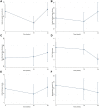Effectiveness and Safety of Combined Application of Three Modes of 2940-nm Erbium:YAG and 1064-nm Neodymium:YAG Lasers in Treatment of Meibomian Gland Dysfunction
- PMID: 34295145
- PMCID: PMC8291964
- DOI: 10.2147/OPTH.S318013
Effectiveness and Safety of Combined Application of Three Modes of 2940-nm Erbium:YAG and 1064-nm Neodymium:YAG Lasers in Treatment of Meibomian Gland Dysfunction
Abstract
Purpose: To study the effectiveness and safety of upper and lower eyelid treatment with combined application of three modes of 2940-nm erbium-doped yttrium aluminium garnet (Er:YAG) and 1064-nm neodymium-doped yttrium aluminium garnet (Nd:YAG) lasers in patients with baggy eyelids (formed by intraorbital fat herniation) who exhibited meibomian gland dysfunction (MGD).
Patients and methods: In this prospective cohort study, patients with baggy eyelid who exhibited MGD received combined laser treatment at baseline, as well as at the 4-, 8-, and 12-week follow-ups. The primary endpoint was meibum quality score at 16- and 24-week follow-ups; secondary endpoints were ocular surface index scores, tear film lipid layer thicknesses, tear break up times (TBUTs), Oxford scheme grades, and meibography grades at 16- and 24-week follow-ups. Adverse events, uncorrected visual acuities, best-corrected visual acuities, and intraocular pressures were also recorded.
Results: Sixteen patients (four men and 12 women; mean age, 56.38 ± 8.64 years) were included. Meibum quality scores at the 16-week follow-up were significantly lower than scores at baseline (p=0.043) and at the 24-week follow-up (p=0.015). TBUT was significantly exacerbated at the 24-week follow-up, compared with baseline (p=0.001) and the 16-week follow-up (p=0.006). There were no significant changes in other parameters. All adverse events were mild and resolved without additional treatment.
Conclusion: Combined application of three modes of 2940-nm Er:YAG and 1064-nm Nd:YAG lasers on upper and lower eyelids significantly improved meibum quality in patients with MGD; it ameliorated symptoms and signs of dry eye disease at 4 weeks after completion of laser treatment.
Keywords: dry eye; erbium:YAG; meibomian gland dysfunction; meibum; neodymium:YAG.
© 2021 Kasetsuwan et al.
Conflict of interest statement
The authors report no conflicts of interest in this work.
Figures



Similar articles
-
Short-term results of the combined application of neodymium-doped yttrium aluminum garnet (Nd:YAG) laser and erbium-doped yttrium aluminum garnet (Er:YAG) laser in the treatment of periodontal disease: a randomized controlled trial.Clin Oral Investig. 2021 Nov;25(11):6119-6126. doi: 10.1007/s00784-021-03911-x. Epub 2021 Apr 4. Clin Oral Investig. 2021. PMID: 33813638 Free PMC article. Clinical Trial.
-
Mechanical meibomian gland squeezing combined with eyelid scrubs and warm compresses for the treatment of meibomian gland dysfunction.Clin Exp Optom. 2017 Nov;100(6):598-602. doi: 10.1111/cxo.12532. Epub 2017 Mar 12. Clin Exp Optom. 2017. PMID: 28295626
-
Comparison of meibomian gland loss and expressed meibum grade between the upper and lower eyelids in patients with obstructive meibomian gland dysfunction.Cornea. 2014 May;33(5):448-52. doi: 10.1097/ICO.0000000000000092. Cornea. 2014. PMID: 24608255
-
Changes in the expression of matrix metalloproteinase-9 after intense pulsed light therapy combined with meibomian gland expression in moderate and severe meibomian gland dysfunction.Cont Lens Anterior Eye. 2021 Jun;44(3):101339. doi: 10.1016/j.clae.2020.05.008. Epub 2020 Sep 15. Cont Lens Anterior Eye. 2021. PMID: 32948417
-
Comparison of fractional neodymium-doped yttrium aluminum garnet (Nd:YAG) 1064-nm picosecond laser and fractional 1550-nm erbium fiber laser in facial acne scar treatment.Lasers Med Sci. 2020 Apr;35(3):695-700. doi: 10.1007/s10103-019-02891-5. Epub 2019 Oct 24. Lasers Med Sci. 2020. PMID: 31646393 Clinical Trial.
Cited by
-
Effectiveness of the Er:YAG Laser in Snoring Treatment Based on Systematic Review and Meta-Analysis Results.J Clin Med. 2025 Jun 19;14(12):4371. doi: 10.3390/jcm14124371. J Clin Med. 2025. PMID: 40566115 Free PMC article. Review.
References
LinkOut - more resources
Full Text Sources

